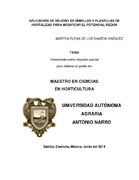Mostrar el registro sencillo del ítem
Aplicación de selenio en semillas y plántulas de hortalizas para modificar el potencial redox
| dc.contributor.advisor | Benavides Mendoza, Adalberto | |
| dc.contributor.author | De los Santos Vázquez, Martha Elena | |
| dc.contributor.other | Ruíz Torres, Norma Angélica | |
| dc.contributor.other | Mendoza Villarreal, Rosalinda | |
| dc.contributor.other | Martínez Amador, Silvia Yudith | |
| dc.date.accessioned | 2014-12-04T09:58:21Z | |
| dc.date.available | 2014-12-04T09:58:21Z | |
| dc.date.issued | 2014-06 | es_MX |
| dc.identifier.uri | http://repositorio.uaaan.mx:8080/xmlui/handle/123456789/133 | |
| dc.description | Realizar aplicaciones de Se en semillas y plántulas de tres especies de hortalizas y verificar el efecto sobre el potencial antioxidante. | es_MX |
| dc.description.abstract | "El selenio es un elemento aplicado en las plantas para mejorar la respuesta frente al estrés así como aumentar su contenido en las partes comestibles. El objetivo de este trabajo fue realizar aplicaciones de selenio en semillas y plántulas de melón, lechuga y tomate y verificar el efecto sobre el crecimiento, el estado antioxidante y la concentración de vitamina C de los tejidos fotosintéticos de las plántulas. El experimento constó de dos fases: en la primera se aplicó el selenio en 0, 0.1 y 1 mg L-1 como pretratamiento de inmersión de las semillas y determinación posterior del peso fresco y seco, área foliar, potencial de oxidación-reducción (ORP) y contenido de vitamina C en las láminas foliares de las plántulas. En la segunda fase se aplicó el selenio en las plántulas en 0 y 2 mg L-1 en la solución nutritiva y 0 y 5 mg L-1 por aspersión foliar a los 15 y 30 días después de la siembra, midiendo las mismas variables de respuesta consideradas en la fase 1. Ambas formas de aplicación de selenio mostraron ser efectivas para modificar positivamente el estado antioxidante y el contenido de vitamina C de las plántulas. Al aplicarlo en la semilla en la Fase 1, el selenio no causó modificaciones en el crecimiento salvo para el caso del melón, en cambio modificó positivamente el estado antioxidante de la plántula y la concentración de vitamina C en los tejidos fotosintéticos de las tres especies. El aporte de selenio a las plántulas por el riego y por aspersión en la Fase 2, causó una mejora significativa en el estado antioxidante de las plántulas y en la concentración de vitamina C en las láminas foliares en las tres especies, mostrando solo pequeños cambios en las variables del peso fresco y seco y el área foliar." | es_MX |
| dc.description.sponsorship | Consejo Nacional de Ciencia y Tecnologia (CONACYT). | es_MX |
| dc.format | ||
| dc.language | Español | es_MX |
| dc.publisher | Universidad Autónoma Agraria Antonio Narro | |
| dc.rights | Acceso Abierto | |
| dc.rights.uri | CC BY-NC-ND - Atribución-NoComercial-SinDerivadas | |
| dc.subject | CIENCIAS AGROPECUARIAS Y BIOTECNOLOGÍA | |
| dc.subject.other | Tomate | |
| dc.subject.other | Melón | |
| dc.subject.other | Lechuga | |
| dc.title | Aplicación de selenio en semillas y plántulas de hortalizas para modificar el potencial redox | es_MX |
| dc.type | Tesis de maestría | es_MX |
| dc.description.abstractEn | Selenium is an element applied in plants to improve the response to stress and to increase their content in the edible parts. The aim of this study was to perform applications of selenium in seeds and seedlings of melon, lettuce and tomato to verify the effect on growth, antioxidant status and vitamin C concentration in photosynthetic tissues of seedlings.The experiment consisted of two phases: in the first selenium was applied at 0, 0.1 and 1 mg L-1 as immersion pretreatment of seeds with the subsequent determination of fresh and dry weight and leaf area, the oxidation-reduction potential (ORP) and concentration of vitamin C in the leaf blades of seedlings. In the second phase the selenium was applied to the seedlings at 0 and 2 mg L-1, in the nutrient solution and at 0 and 5 mg L-1 as foliar spray at 15 and 30 days after seeding. In the second phase the same response variables mentioned for the first phase were measured. Both forms of selenium application shown to be effective, and positively changed the antioxidant status and the concentration of vitamin C of seedlings. Selenium applied to the seeds in the first phase caused no changes in seedling growth except in the case of melon; however the antioxidant status of the seedlings and the concentration of vitamin C in photosynthetic tissues of the three species were positively modified with selenium application. The application of selenium by irrigation and leaf spraying in the second phase caused a significant improvement in the antioxidant status and in the concentration of vitamin C in the leaves in the three species, showing only minor changes in the variables of fresh and dry weight, and leaf area. | |
| dc.type.version | Versión publicada | |
| dc.audience | Estudiantes | |
| dc.audience | Investigadores | |
| dc.publisher.place | Saltillo, Coahuila, México | es_MX |
| dc.type.thesis | Digital |
